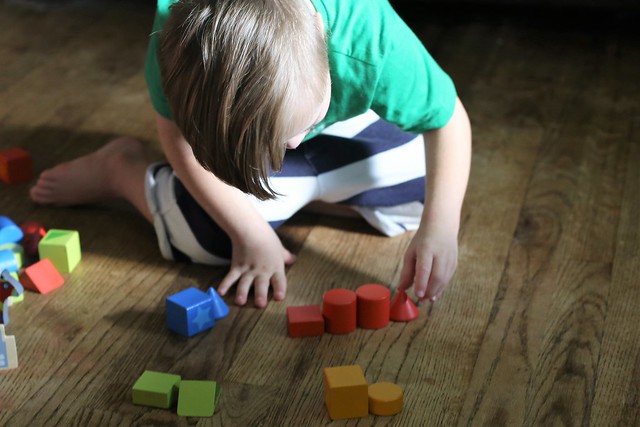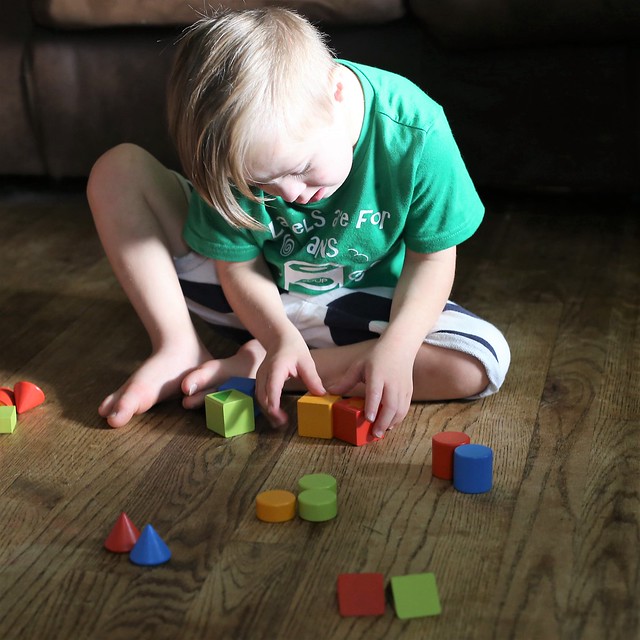This post contains gifted products from Cubbie Lee Toy Company.
Up until Liam was born, I didn't think much about the quality of play. Play was just something that all kids did. I certainly didn't think in terms of gross motor skills, fine motor skills, language skills, and cognitive skills. Learning those valuable skills was just something I took for granted until my fourth child was diagnosed with Down syndrome. That diagnosis introduced us to a whole new world, including actually thinking about and researching how much play matters.
See, playing is more than just something kids do. Play not only inspires creativity and imagination, but it also leads to healthy brain development, and it builds fine motor, gross motor, language, cognitive and social skills. Kids can actually learn more through play at an early age, than by sitting down with learning materials, so it's important to fill your home with quality toys and encourage kids to play as often as possible!
We were introduced to the concept of quality play when Liam was 2 months old. At that point, home-based early intervention therapy services began. A speech therapist, an occupational therapist, and a physical therapist began to visit our home each week. I closely observed what the therapists were working on, asked lots of questions, began to research toys and activities that helped build important skills, and asked for toy recommendations.
It turns out that we already had a lot of quality toys, but from then on, I became very selective about the toys that we purchased. I also encouraged Liam to play with a wide variety of toys that would help him develop and grow! Using play to help build fine motor, gross motor, language, cognitive and social skills isn't just for kids with special needs. It's important for kids of ALL abilities!
Child Development Skills
Before focusing on quality play, it's important to understand the five main areas of child development!
Gross Motor - Gross Motor skills involve the large muscles of the torso, legs, and arms. They are the "larger" movements that a child makes. Pulling up, Crawling, Walking, Running, Jumping and Climbing are great examples!
Fine Motor - Fine Motor Skills involve coordinating small muscles through movement. Think hand - eye coordination, and small movements such as grasping, reaching, moving objects, lacing objects, tying shoes, and using pencils/crayons/scissors.
Language and Speech - This one is self explanatory! It's simply the development of speech and language.
Cognitive - Cognitive Skills are the main skills the brain uses to think, learn, read, reason, understand, remember, and pay attention.
Social and Emotional - Social and Emotional Skills are essential life skills! These skills help kids learn how to manage feelings, feel and show empathy, establish postive relationships, and solve problems.
How To Choose A Quality Toy
Before choosing a toy, ask yourself these questions:
- Is the toy versatile?
- Will the toy grow with my child?
- Can this toy be played with by kids of different ages?
- Will this toy help build skills in all five areas of child development, or at least focus on several areas?
If the answer is yes to most, if not all, of these questions, it's a clear winner!
Toys For All Areas of Development
There are so many toys out there, and it's tough to know what to choose! Filling your home with a few main toys from each area of development will cover all of the bases!
Gross Motor:
- Slides
- Pop-Up Tunnels
- Ride On Toys - Ride-Ons, Scooters, Balance Bikes, Trikes, Bikes, plasma cars
- Climbing Toys
- Trampolines
- Blocks
- Hula Hoops
- Balance Beams
- Hop Balls or Bouncy Ride-On Animals
- Standing Easels
- Water Table
- Train Sets
Fine Motor:
- Lacing Sets
- Bead Mazes
- Wooden Puzzles
- Crayons and Paper/Coloring Books
- Arts and Crafts
- Food Cutting Sets
- "Fishing Rod" Toys
- Stacking Toys
- Blocks
- Gears
- Lacing Shoes
- Shape Sorters
- Pounding Toys
- Filling Toys
- Coin Slot Toys
- Pop Beads
- Nesting Toys
- Play Dough
- Bristle Blocks
Cognitive:
- Building Sets
- Blocks
- Squigz
- Puzzles
- Peg Boards
- Stacking Toys
- Magnetic Tiles
- Puzzle Balls
- Activity Cards
- Board Games
Speech and Language:
- Books (READ, READ, READ!)
- Flashcards (We love touch & feel flashcards)
- Talking Tubes
- Microphones
- Toobaloo Auditory Feedback Phone
- ANY toy in general works, as long as you use descriptive language while playing
Social and Emotional:
- Games
- Books or flashcards about feelings
- Dolls or Animal Toys
- Outdoor toys that encourage playing together
- Chore Charts and Daily Planners
- Musical Toys
Building Fine Motor, Gross Motor, Language and Cognitive Skills with Cubbie Lee
Now that we've talked about the five main areas of child development, and choosing the perfect toys for quality play, I want to highlight a toy company that gets it right! Cubbie Lee Toys offers classic toys that encourage creativity and imagination, and are a perfect fit for building skills in all areas of development. We have a good mix of plastic "noisy" toys and classic wooden toys in our home, and both have been beneficial for our kids. Cubbie Lee Toys is the go to for quality wooden toys that are timeless, fun, and educational!
I think blocks and building sets are versatile toys that tackle all 5 areas of child development. We have some wooden blocks, but I was looking for a more advanced set for Liam, that would inspire creativity. The Knight & Dragon Castle Wooden Building Block Set was the perfect choice!
Ideas for Developmental Play:
- Stack the blocks to work on fine motor skills...bonus points for knocking it down!
- Vocally identify colors and shapes while playing.
- Sort the blocks by color.
- Sort the blocks by shape.
- Play on the floor to encourage gross motor movement.
- Work together to build something with a friend or family member.
One of my favorite features of the Knight & Dragon Castle Wooden Building Block Set is the easy cleanup and storage, thanks to the sturdy storage box with a rope handle!
We have a tons of toys that address fine motor skills, but one thing we didn't have was a food cutting set. It's definitely a skill that Liam needs to work on. The Wooden Fruit Cutting Play Food Set was super cute, and really helpful for addressing this valuable life skill! It's still a bit difficult for him to do, but with a few minutes of practice each day, he's improving! (Confession: My girls, ages 7 and 11, love it, too!)
Ideas for Developmental Play:
- Vocally identify each fruit and color while playing.
- Place the fruit in a pile and ask your child to choose the proper fruit when you say the name. (Where is the Strawberry? That's the Strawberry! The Strawberry is red!)
- Start with hand over hand cutting, then progress to just helping your child start the cutting process until they can do it on their own.
- Play with a friend or family member!
A few more tips for quality play:
- Play on the floor to encourage movement.
- Make play about fun, and don't force the learning aspect. Kids will learn THROUGH play.
- Don't forget about the importance of vertical play! Think easels, chalkboards mounted on walls, magnets on the fridge, and sticky paper murals!
- Talk to your child as often as possible, from an early age. Use descriptive language to identify colors, shapes, objects, feelings, actions, etc, while talking.
- Make reading a priority each!
- Consider playing games together as a family. There are so many fun, age appropriate games that address all areas of development.
- Rotate toys to keep things fun and interesting!























I love toys that encourage creativity. These blocks look great!
ReplyDeleteI agree! The blocks are so cute. Lily and Lexie even play with them!
Delete